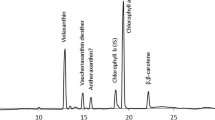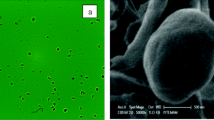Abstract
The carotenoid composition of the astaxanthin-producing green alga Chlorella zofingiensis was investigated using high-performance liquid chromatography. Astaxanthin, adonixanthin, and zeaxanthin are the major carotenoids in this alga. The pigment pattern was characterized during the accumulation period, and in response to diphenylamine (DPA), an inhibitor of carotenoid biosynthesis. An increase in zeaxanthin followed by a decrease in xanthophyll was seen after the induction of astaxanthin biosynthesis by glucose. This biphasic kinetics of zeaxanthin was parallel to the marked increase in adonixanthin (from 0 mg g−1 to 0.21 mg g−1) and astaxanthin (from 0.05 mg g−1 to 0.35 mg g−1) and decrease of β-carotene (from 0.30 mg g−1 to 0.03 mg g−1). More importantly, unlike the Haematococcus alga, in which there was a high β-carotene accumulation after DPA treatment, C. zofingiensis showed an accumulation of extra zeaxanthin instead of β-carotene after treatment of the cells with DPA. All these results observed in vivo studies corroborate the observations in vitro studies at the enzyme level that zeaxanthin is a substrate for the carotenoid oxygenase in C. zofingiensis. It is suggested that zeaxanthin might be an important intermediate and not an end product of the biosynthetic pathway of astaxanthin. Therefore, a new pathway for astaxanthin formation by C. zofingiensis, which is different from that of the other astaxanthin-producing microorganisms, is proposed. An understanding of the astaxanthin biosynthetic pathway may yield important information toward the optimization of astaxanthin production, especially for the improvement of astaxanthin through genetic manipulations.





Similar content being viewed by others
References
Andrewes AG, Phaff HJ, Starr MP (1976) Carotenoids of Phaffia rhodozyma, a red-pigmented fermenting yeast. Phytochemistry 15:1003–1007. doi:10.1016/S0031-9422(00)84390-3
Baroli I, Do AD, Yamane T, Niyogi KK (2003) Zeaxanthin accumulation in the absence of a functional xanthophyll cycle protects Chlamydomonas reinhardtii from photooxidative stress. Plant Cell 15:992–1008. doi:10.1105/tpc.010405
Bertram JS (1999) Carotenoids and gene regulation. Nutr Rev 57:182–191
Breitenbach J, Misawa N, Kajiwara S, Sandmann G (1996) Expression in Escherichia coli and properties of the carotene ketolase from Haematococcus pluvialis. FEMS Microbiol Lett 140:241–246. doi:10.1111/j.1574-6968.1996.tb08343.x
Demmig-Adams B, Adams WW (2002) Antioxidants in photosynthesis and human nutrition. Science 298:2149–2153. doi:10.1126/science.1078002
Dufossé L, Galaup P, Yaron A, Arad SM, Blanc P, Murthy KNC et al (2005) Microorganisms and microalgae as sources of pigments for food use: a scientific oddity or an industrial reality? Trends Food Sci Technol 16:389–406. doi:10.1016/j.tifs.2005.02.006
Fan L, Vonshak A, Gabbay R, Hirshberg J, Cohen Z, Boussiba S (1995) The biosynthetic pathway of astaxanthin in a green alga Haematococcus pluvialis as indicated by inhibition with diphenylamine. Plant Cell Physiol 36:1519–1524
Guerin M, Huntley ME, Olaizola M (2003) Haematococcus astaxanthin applications for human health and nutrition. Trends Biotechnol 21:210–216. doi:10.1016/S0167-7799(03)00078-7
Harker M, Young AJ (1995) Inhibition of astaxanthin synthesis in the green alga, Haematococcus pluvialis. Eur J Phycol 30:179–187. doi:10.1080/09670269500650961
Huang JC, Wang Y, Sandmann G, Chen F (2006) Isolation and characterization of a carotenoid oxygenase gene from Chlorella zofingiensis (Chlorophyta). Appl Microbiol Biotechnol 71(4):473–479. doi:10.1007/s00253-005-0166-8
Ip PF, Chen F (2005) Production of astaxanthin by the green microalgae Chlorella zofingiensis in the dark. Process Biochem 40:733–738. doi:10.1016/j.procbio.2004.01.039
Ip PF, Wong KH, Chen F (2004) Enhanced production of astaxanthin by the green microalgae Chlorella zofingiensis in mixotrophic culture. Process Biochem 39:1761–1766. doi:10.1016/j.procbio.2003.08.003
Jacobson GK, Jolly SO, Sedmark JJ, Skatrud TJ, Wasileski JM (2000) Astaxanthin over-producing strains of Phaffia rhodozyma. Method for their cultivation and their use in animal feeds. US Patent 6,015,684
Lorenz RTBB, Cysewski GR (2000) Commercial potential for Haematococcus microalgae as a natural source of astaxanthin. Trends Biotechnol 18:160–167. doi:10.1016/S0167-7799(00)01433-5
Masojidek J, Kopecky J, Koblizek M, Torzillo G (2004) The xanthophyll cycle in green algae (Chlorophyta): its role in the photosynthetic apparatus. Plant Biol 6(3):342–349. doi:10.1055/s-2004-820884
Olaizola M (2000) Commercial production of astaxanthin from Haematococcus pluvialis using 25,000-liter outdoor photobioreactors. J Appl Phycol 12:499–506. doi:10.1023/A:1008159127672
Stahl W, Sies H (2005) Bioactivity and protective effects of natural carotenoids. Biochim Biophys Acta 1740:101–107
Steinbrenner J, Linden H (2001) Regulation of two carotenoid biosynthesis genes coding for phytoene synthase and carotenoid hydroxylase during stress-induced astaxanthin formation in the green alga Haematococcus pluvialis. Plant Physiol 125:810–817. doi:10.1104/pp.125.2.810
Acknowledgements
The financial support of the grant from the Frontier Research Grant of the YICCAS (A3J0708DB-010), and the Sci-tech Development Grant of Shandong (No. 2007GG2QT06020) are gratefully acknowledged.
Author information
Authors and Affiliations
Corresponding author
Rights and permissions
About this article
Cite this article
Wang, Y., Chen, T. The biosynthetic pathway of carotenoids in the astaxanthin-producing green alga Chlorella zofingiensis . World J Microbiol Biotechnol 24, 2927–2932 (2008). https://doi.org/10.1007/s11274-008-9834-z
Received:
Accepted:
Published:
Issue Date:
DOI: https://doi.org/10.1007/s11274-008-9834-z




